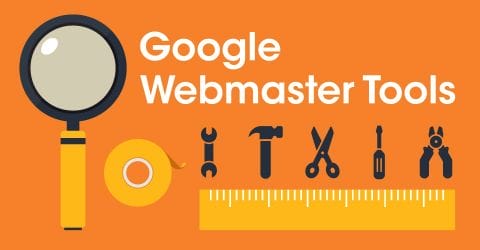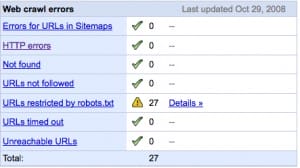Everyone Should be Using Google Webmaster Tools To Improve Their Website

Google Webmaster Tools – AKA Google Search Console – provides valuable insights into what is happening on your website
This is information that you either can’t get anywhere else. And, it’s free directly from Google
→ DIAGNOSTICS: Web Crawl Errors
We all want the search engines to find and index ALL the pages on our website, right? Okay, sometimes there are certain pages we want to hide and we can always exclude the bots from those pages with listings in our robots.txt file. But by and large we want our web pages to show up in Google and Yahoo. After all, that’s where our site visitors come from, the search engines! However, linking errors inside our site, or link errors on other sites, can result in the bots not finding important pages on our site.
The web crawl error list below shows you where the problems are so you can go about fixing them. It will tell you if the errors are http related, or 404 related, or are unreachable for some reason: it’s really a very complete list. And it sure beats you spending the time to manually click all the links in your site to make sure they work!
Does Google get something out of this? Of course they do! Google wants to be sure it finds ALL the content on your site, and this tool makes it more likely site owners will fix the problems Google finds.
It’s a win-win.
→ DIAGNOSTICS: Content Analysis
“Content Analysis” sounds more sophisticated than it actually is, but that doesn’t make it any less useful. Here Google looks at your title and meta description tags to see if you have duplicate tags, or if the tags are too short or too long.
Again, self-interest is at work: Google wants all site owners to have useful, descriptive tags because the engines rely on your tag to help them understand your site content. And since you want the engines to correctly understand your site content, you do want to know if your tags are anything less than optimal!
→ STATISTICS: Top Search Queries
 Now things really get interesting. This tool tells you what words visitors entered into Google (search terms) that led them to your site! This is extremely useful data which you can use to improve your site and learn what subjects your visitors are interested in.
Now things really get interesting. This tool tells you what words visitors entered into Google (search terms) that led them to your site! This is extremely useful data which you can use to improve your site and learn what subjects your visitors are interested in.
The data is divided into two categories: “Impressions” and “Traffic”. The first category is search terms that Google displayed your site as a search result; the second is the search terms that resulted in searches actually arriving at your site. Note the distinction.
If there are terms in the Impressions list that don’t show up in the Traffic list, and you feel you should be getting visitors for those Impressions terms, then you need to improve the content on your site that relates to those terms as well as make sure the title and meta description tags on those pages are compelling and accurate.
As usual, your efforts are going to benefit Google as well, allowing it to better understand and describe your site content to searchers.
Everyone Should be Using Google Webmaster Tools To Improve Their Website. Click To Tweet→ STATISTICS: What Googlebot Sees
Googlebot is the automated software used by Google to “crawl” and index the web. This data tells you the text of the links that point to your site from other sites. Remember that the text of external (or “inbound”) links to your site is used by Google to help rank your site!
Ideally, the link text should include important keywords on the page it is linking to, as that will help the pages rank in Google.
→ STATISTICS: Crawl Stats
Here you can see how often the Googlebot is visiting your site and how many pages it crawls. I find it rather amazing how frequently the bot comes back to a site to make sure it isn’t missing anything new. You can, to a limited extent, control how often Google crawls your site by values used in your XML sitemap file.
→ STATISTICS: Index Stats
This is a very useful page with shortcuts to Google’s Advanced Search feature. You can learn how many pages on your site are in Google’s index; how many links on other sites point to a page on your site (this is an approximate figure), and what content on your site is in Google’s cache, and other sites that Google considers “similar” to yours.
Use that information to find competitors and then see how they rank in Google for search terms that are important to you.
→ INBOUND LINKS
The data in this section expands somewhat on the Index Stats data. Here you can see: which pages on your site are linked to from other sites; which pages on your site Google might show in search results; and which pages on your site are linked internally (to each other).
→ SITEMAP
A Google sitemap is a very useful tool that you can use to communicate directly with the specific Google search bot that contains specific information about your site. In it you can list all the URLs you want to be sure the bot finds and indexes, assigns priorities to different URLs, and indicate how frequently you want Google to revisit your site.
Rosemary Brisco
AI Training Videos
AI Consulting and Training
Master today’s most effective productivity tools.
ToTheWeb ensures your route to capitalizing on the immense power of AI is fast and efficient. Our AI consulting and training programs will quickly enable your marketing team to adopt solutions to optimize operations and boost performance.
Learn about our generative AI and ChatGPT consulting and training programs




